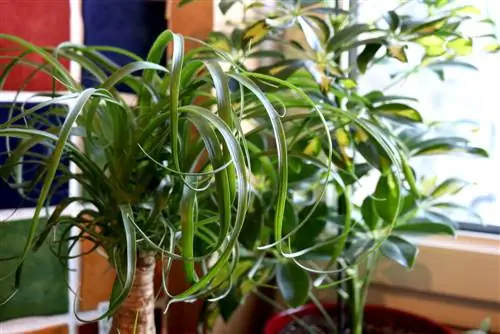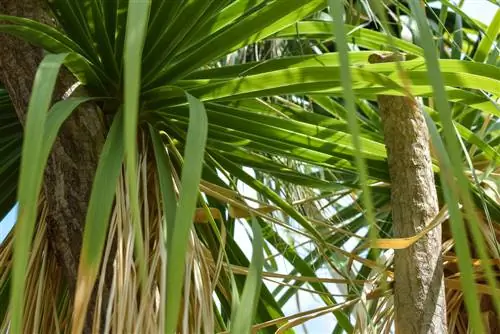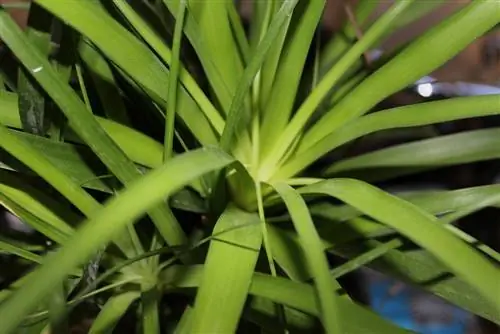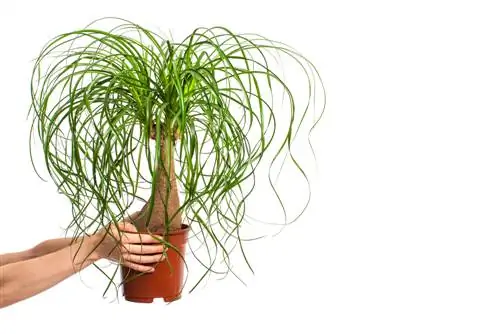- Author admin [email protected].
- Public 2023-12-16 16:46.
- Last modified 2025-01-23 11:22.
Originating from Mexico, the elephant's foot prefers warmth and light, but is still quite easy to care for and beginner-friendly. This means that even people without the proverbial green thumb can venture into this exotic-looking plant without any major concerns.
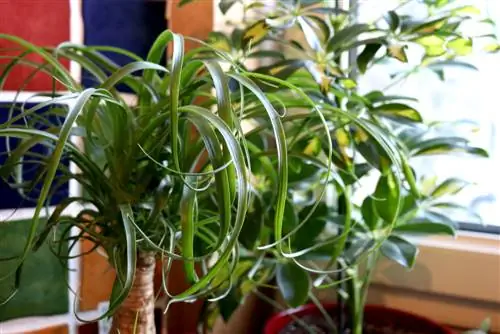
How do I properly care for an elephant foot?
Caring for an elephant's foot requires a bright, warm location, moderate watering, nutrient-poor substrate and occasional repotting. Avoid drafts, waterlogging and frosty temperatures to ensure optimal growth.
Buy an elephant foot
When buying an elephant foot, pay attention to the he alth of the plant. You can recognize them by their strong, green leaves. Deformities and/or cottony spots on the leaves indicate a pest infestation, while brown or yellowish discoloration indicates disease or care errors. Also look at the location, the plant should get enough light and not be in a drafty place.
The ideal location
The elephant's foot needs a lot of light and warmth to thrive. So give him a bright place by the window. The blazing midday sun can easily lead to sunburn, so east or west windows are better suited than a south window. The plant tolerates temperatures of up to 30 °C without any problems, but cold temperatures less well.
Suitable substrate
Since the elephant's foot does not like waterlogging, the substrate should definitely be loose and permeable. You can loosen up ordinary potting soil a little by mixing it with clay granules and/or sand. Cactus soil is also suitable for elephant foot.
Water and fertilize correctly
The relatively undemanding elephant foot does not require very many nutrients. It can store these, as well as water, in its thick trunk. It can survive longer dry periods without any problems. It doesn't need to be watered much or fertilized regularly. A little cactus fertilizer in spring, perhaps a second dose in summer, is enough for him.
Repotting the elephant foot
You should repot your elephant foot after about three to four years. At the latest when the broad base of the trunk fills the entire pot or when the roots start to grow out of the pot, it is time to repot. Since the elephant's foot grows quite slowly, this will probably take a while.
The elephant's foot in the garden
The elephant's foot is generally kept as a houseplant in this country. It does not tolerate temperatures around freezing point well. In a nice and warm summer, you can put the plant outside, for example on the balcony or terrace.
Slowly get the elephant's foot used to the fresh air and, above all, the sun. A place in light shade and an initial stay in the garden for an hour makes it easier to get used to it. If the night temperatures drop to around 7 °C or even lower in autumn, then bring the elephant's foot back into the apartment.
The pruning
In principle, an elephant's foot does not need to be trimmed, but pruning is certainly possible. If the plant is too big for you, simply shorten the trunk to the desired height and close the cut with a special agent. This will prevent possible infections. Your elephant foot will recover very soon and sprout again.
The elephant's foot in winter
As a tropical plant, the elephant's foot is not hardy. There are two options for wintering. On the one hand, you can care for it in your living room all year round, but on the other hand, you can also keep it a little cooler over the winter.
The second option is definitely preferable, because during the winter rest your elephant foot can recover and gain new strength for the coming season. Watering and fertilizing are not necessary during this time. Temperatures around 10 °C are ideal. An elephant's foot cannot tolerate frost at all.
Diseases and pests
Sometimes the leaves of an elephant's foot turn yellowish, this is usually due to care errors or rotting roots. These are caused by waterlogging. It is also possible that the elephant's foot suffers from greatly fluctuating temperatures. You should urgently take action here.
Spider mites and/or scale insects usually indicate that the air is too dry. Inspect your elephant foot regularly for pest infestation, especially during the winter months. Mealybugs and mealybugs also occasionally occur. But this doesn't happen all too often.
The most important things in brief:
- beginner-friendly and easy to care for
- Location: bright and warm
- Temperature: around 20°C to 25°C
- watering: little to moderate
- Avoid drafts and waterlogging
- less susceptible to diseases and pests
- repot every 3 to 4 years
- Suitable substrate: permeable, nutrient-poor potting soil, possibly mixed with clay granules or sand, cactus soil
- Wintering: moderately cool and not too dark
Tip
Don't overdo it on an elephant's foot. Little watering and fertilizing, a nutrient-poor substrate, but plenty of light and warmth allow the plant to thrive best.

